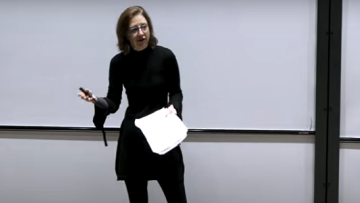11:00
The flow equation approach to singular SPDEs.
Abstract
I will give an overview of a recent method introduced by P. Duch to solve some subcritical singular SPDEs, in particular the stochastic quantisation equation for scalar fields.
15:30
Sharp interface limit of 1D stochastic Allen-Cahn equation in full small noise regime
Abstract
We consider the sharp interface limit problem for 1D stochastic Allen-Cahn equation, and extend a classic result by Funaki to the full small noise regime. One interesting point is that the notion of "small noise" turns out to depend on the topology one uses. The main new idea in the proof is the construction of a series of functional correctors, which are designed to recursively cancel out potential divergences. At a technical level, in order to show these correctors are well behaved, we also develop a systematic decomposition of functional derivatives of the deterministic Allen-Cahn flow of all orders, which might have its own interest.
Based on a joint work with Wenhao Zhao (EPFL) and Shuhan Zhou (PKU).
Which of the 93 student lectures on our YouTube Channel is most watched? Perhaps the 'Introduction to Mathematics' or a spot of 'Linear Algebra'? Or possibly 'Probability'?
Well, they're all popular, but the most watched lecture on the channel is 'Introductory Calculus'. YouTubers (and the algorithm) love it.
So we're showing 4 lectures from its follow-up, 'Multivariable Calculus' starring Sarah Waters. It's a first year lecture taken in the second term of the year.
Discrepancy of graphs
Part of the Oxford Discrete Maths and Probability Seminar, held via Zoom. Please see the seminar website for details.
Abstract
The positive discrepancy of a graph $G$ is the maximum surplus of edges in an induced subgraph of $G$ compared to its expected size. This quantity is closely related to other well studied parameters, such as the minimum bisection and the spectral gap. I will talk about the extremal behavior of the positive discrepancy among graphs with given number of vertices and average degree, uncovering a surprising pattern. This leads to an almost complete solution of a problem of Alon on the minimum bisection and let's us extend the Alon-Boppana bound on the second eigenvalue to dense graphs.
Joint work with Eero Räty and Benny Sudakov.
Geodesics networks in the directed landscape
Part of the Oxford Discrete Maths and Probability Seminar, held via Zoom. Please see the seminar website for details.
Abstract
The directed landscape is a random directed metric on the plane that is the scaling limit for models in the KPZ universality class (i.e. last passage percolation on $\mathbb{Z}^2$, TASEP). In this metric, typical pairs of points are connected by a unique geodesic. However, certain exceptional pairs are connected by more exotic geodesic networks. The goal of this talk is to describe a full classification for these exceptional pairs.


